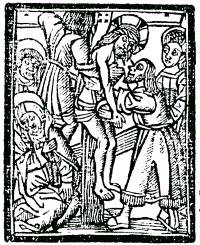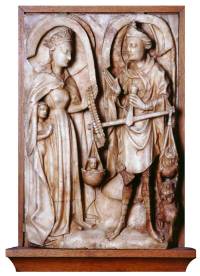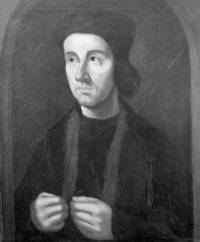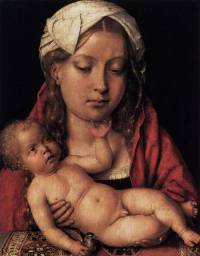Stephen Bates - Research
Overview

My thesis examines the changing position of the Virgin Mary during the English reformations of the sixteenth century. It explores the unsettling of established Marian tropes in order to assess the development of theological belief and its interaction with shifting patterns of piety. It also analyses the use of the Virgin as an archetype for England’s 'female kings', Mary and Elizabeth. Although she had been a central figure in medieval Christianity, the Virgin’s role in the incarnation and her place in the scheme of salvation lacked clarity, leaving space for religious speculation. Consequently, re-imagining Mary became an aspiration for Catholic evangelicals and Renaissance humanists, and one of the identifying symbols of Protestantism.
Situated at the crossroads of cultural history (representations of the Virgin) and social history (devotional practice), this research will contribute to the post-revisionist debate within Reformation studies (Wooding, 2000; Wizeman, 2006) and also engage with key writers on the sociology of religion, such as Emile Durkheim, Peter Berger and Max Weber. Consequently, it promises insights into paradigm formation, the activity of collective consciousness and the birth of confessionalism.
|
|
 |
Click 'play' to hear the Magnificat from John Sheppard's 'Great Service', composed between 1549 and 1552 during the reign of Edward VI.
|
Chapters
 |
1. Between Doctrine and Devotion: The Place of the Virgin in Late Medieval EnglandMy first chapter provides the context to subsequent questions of continuity and innovation in the rest of the thesis by examining both the representation of the Virgin by late medieval Catholicism and the experience of the cultus Virginis in English communities. Situating Mary in the broader hagiographical landscape has allowed for an exploration of the ways in which devotees related to her and an understanding of their expectations. This elucidates the origins and growth in popularity of lay Marian piety. An exposition of the established Mariological tropes, such as the Immaculate Conception and her role as co-redemptrix, swooning at the foot of the cross, demonstrate that there were outstanding theological issues concerning Mary at the turn of the sixteenth century. In doing so, I have highlighted the fissures in the edifice of apparent Mariological homogeneity in this period, informing a broader absence of rigid dogma in pre-Reformation Catholicism and a surprising contentment with heterodoxy.
|
2. Problems and Possibilities: Popular Marian Piety as Spiritual AuthenticityMy second chapter considers the different ways in which the theology and devotion set out in the previous chapter were unsettled by the critiques of catholic evangelicals, renaissance humanists and early (pre-Lutheran) reformers. It situates these challenges in their European context but also considers local contests with Lollardy. It includes a focus on the development of the rosary devotion, the Lady Psalter, as part of a demonstration of the use of the Virgin as a touchstone for both orthodoxy and authentic spirituality. It also assesses the relationship of mariological praxis with both the devotio moderna and renaissance humanism, in order to identify their impact on the trend toward religious interiorisation and lay Marian mysticism. The Erasmian re-imagining of the Virgin is particularly highlighted, since the humanist’s pursuit of the Philosophia Christi and his engagement with England’s unique brand of Marian devotion would subsequently be appropriated by the Henrician reformers. Consequently, I argue that the challenge to late medieval mariology comes consistently from the notion that devotional integrity is lacking, and suggest that the pressure to reform popular piety was beginning to compel change prior to the break with Rome. St. Michael weighing souls, with Mary intervening by placing prayer beads on the beam of the scales (at left),
from a fifteenth-century Nottinghamshire alabaster, now in the chapel of Pembroke College, Cambridge.
Note the votary hidden beneath the Virgin's mantle.

|
|
|
|
3. Reconstructing Mary: the reformation of the VirginMy third chapter traces changing government policy concerning the Virgin from Henrician reform through to Edward’s radical religious policies. Through a close reading of contemporary reactions it shows the variety of ways in which the Virgin was re-imagined. In so doing, I consciously weave a number of research questions into the narrative, concerning the nature of the decisions made and the consequences for lay religious life, in order to contextualise the difficult path those seeking to reform the Virgin had to tread to avoid throwing out the infant Christ with the mariological bath-water. The impact of the dissolution of the cult of the saints on popular piety, the use of theological verities to exhibit religious identity and the conversion of the Virgin into a godly Protestant woman are all examined in turn, to asess the affect on festivals, pilgrimage, prayer, rosary devotions, associated confraternities, and apparitions. The chapter touches on changing attitudes to 'churching' and considers the differences in the way women venerated the Virgin from men. Consequently, parts of this chapter engage with broader questions of gender, for example, whether changes in Marian piety reflected the purported loss of feminism in Protestantism.  This portrait of Cuthbert Tunstall (c. 1540) still hangs in the chapel named after him in Durham Castle. Originally it depicted the conservative Prince Bishop saying his rosary, but these were painted over during the reign of Edward VI as representative of Catholic confessional identity. This portrait of Cuthbert Tunstall (c. 1540) still hangs in the chapel named after him in Durham Castle. Originally it depicted the conservative Prince Bishop saying his rosary, but these were painted over during the reign of Edward VI as representative of Catholic confessional identity. |
4. Virgin Queens: reimagining Mary in the reign of Mary TudorMy final chapter extends the story of the deconstructed, reimagined, reassembled and appropriated Virgin to the reign of Mary Tudor. By examining the new regimes engagement with mariology, it contributes to the debate concerning the nature of the Queen's religious programme: whether it is better considered as restoration, reaction, a prototype for Tridentine reform, or a unique attempt to produce an authentic yet Catholic spirituality on the Erasmian model. One of the main points of discussion here is the novelty of female kingship. The lack of a constitutional definition for 'queen' allowed considerable scope for innovation and the appropriation of tropes: the apotheosis of the monarch; virginity as a sacred quality; a woman as mother of her people and so forth. The chapter concludes with an assessment of the 1558 settlement, to consider whether Elizabeth borrowed from her half-sister and, through a comparative analysis, to consider the potential in Mary’s policy and potentially highlight a missed opportunity in English Catholic polemic. Here, I draw on themes of gender and patriarchy found in the previous chapter. Michael Sittow's Virgin and Child (1515) is believed to have used Katherine of Aragon as a model,
neatly capturing the ambivalent relationship of royalty and sanctity.
 |
|



